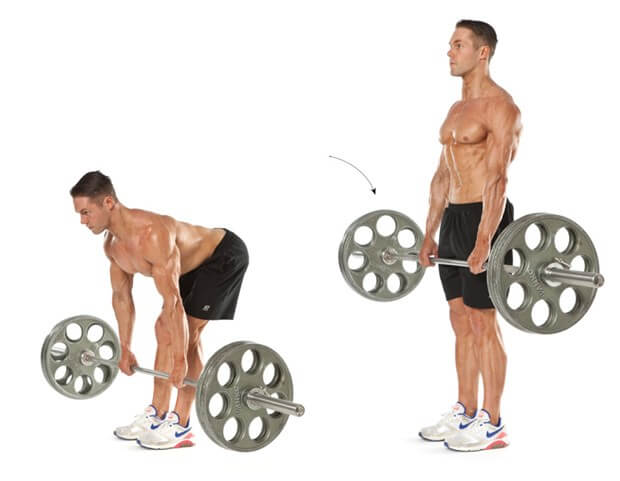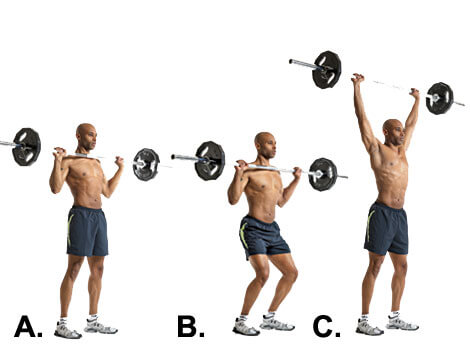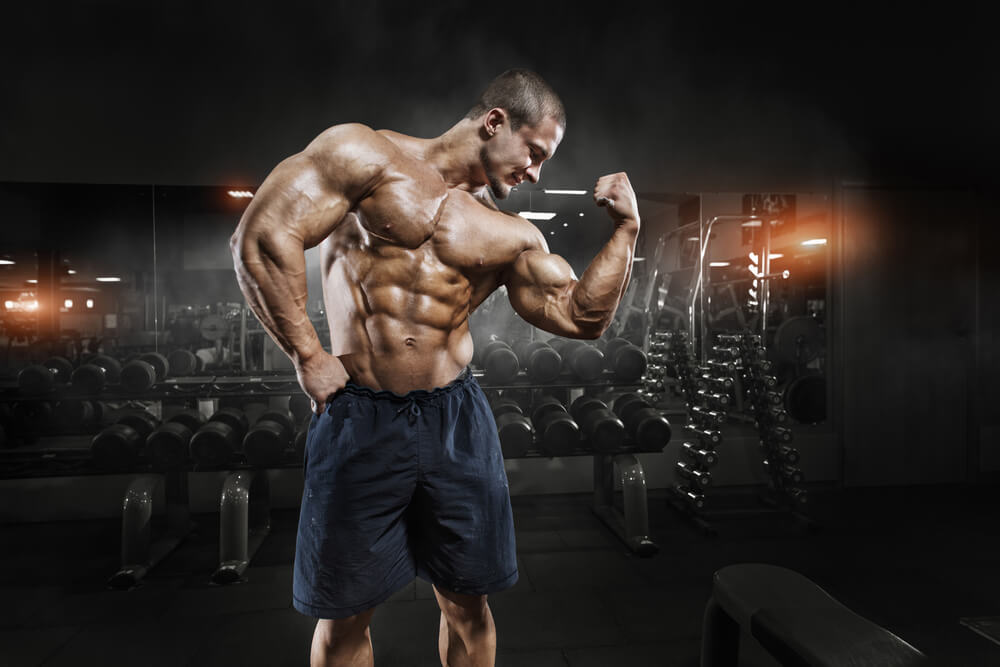
Want to know the top three exercises that should be in your workout? If so, that’s great. Why? Simple. You came to the right place. We tell you the top three and how to do them.
Training sessions are supposed to be fun, but efficient. Yet, many people include exercises that are either unnecessary or do not fit their goals. We’ll help you put an end to those issues.
How?
With three exercises you can plug into almost any workout program to help you optimize your training.
The main goal of these movements is to hit frequently ignored muscle groups during training in a practical way. Importantly, all of these movements can be used for a hypertrophy, strength or sport-conditioning program.

#1 Romanian Deadlift (RDL)
Often overlooked, this is the smarter, more refined brother of the conventional deadlift workout. The main focus in this exercise is to use the posterior chain with an emphasis on the hamstrings. But make sure to check out how to deadlift properly before getting into doing deadlifts.
Why is the RDL better than the conventional deadlift?
Simple, the reason is because that deadlift does not generally have a controlled eccentric portion. People will recruit plenty of muscle to pull the bar up, but they frequently drop it quickly on the way back down.
There’s not as much tension in the muscle, so we miss out on some muscle activation (McAllister 2014). This muscle activation is one of the keys to increase muscle size and great for strength training. Obviously, if you are a powerlifter, you will need to keep the traditional or sumo deadlift in your program as it is tested in competition. I have both variations in my program – but that’s mainly because I’m a PowerBuilder (bodybuilder plus powerlifter). I would advise to keep the RDL in a rep range of 6 to 12 to prevent injuries.
In athletes, the biceps femoris and semitendinosus are the two most commonly injured muscles of the hamstring (Askling 2007).
Why?
They are subject to the maximum amount of stretch during a sprint. The RDL serves as an excellent way to prevent injury by helping to develop the hamstrings.
One of the other benefits of the RDL is that it activates the calf (gastrocnemius) more than other hamstring exercises (McAllister 2014). Including this exercise can help bring up another lagging body part in addition to developing overall strength and size.
When doing the RDL, most people use much less weight than the conventional deadlift. Your focus is on keeping tension in the hamstrings throughout the movement. When you reach the top, squeeze your glutes to ensure they are being activated. Imagine trying to crack a nut between those butt cheeks. You will also want to keep your back straight.
No rounding allowed!
This Is The Set-Up
Place your feet about shoulder width apart, similar to your squat or normal deadlift stance. Use an overhand position on the bar. Your knees should be slightly bent. Keep your head up throughout the lift. This will help keep your back aligned properly. Check your form in the mirror as you come up.
Your focus is on the hamstrings, which should feel a slight stretch at the bottom of the start point. Pull using the hamstrings and glutes, not your lower back. Squeeze your glutes at the top, but do not hyperextend your back. Slowly lower the bar to the start point, again focusing on the hamstrings on the way down.

#2 Push-Press
The push-press is like the military press, but much less stressful on the shoulder joint. It has also been a staple of Olympic lifting routines for decades. All you do to modify the standard barbell OHP to a push-press is dip (bend knee) slightly as the weight comes down. This helps absorb contact into the shoulder during your shoulder workouts. As you push the barbell overhead, extend your legs and drive up onto your toes. Your heel may lift slightly off the ground – that’s fine.
You can also review how to increase shoulder mobility.
I’ve found that the most common injury in the gym is to the shoulders. It is usually caused by the bench press or some other shoulder press variation. These are great exercises. They are very beneficial when used properly, but can be difficult to progressively overload throughout a training program.
The push-press solves that problem because it incorporates multiple body parts with a main focus on your shoulders. It allows more reps and generally more weight on the bar than the traditional overhead barbell press. Plus, if you are an athlete it transitions very well to most sport-based movements (like jumping to catch a pass) because it can help develop explosive movements.
One study showed that the demand of the push-press is comparable with the jump squat (Lake 2014). This makes it an efficient exercise to target the whole body and, as mentioned, will translate to sport performance.
This Is The Set-Up
Start with the bar racked, hands roughly bench press width apart. Keep your elbows under the bar. Do not push them too far past it. If you’re an Olympic lifter you can use the first part of the lift to work on adjusting from the clean-catch position to press position.
Step out of the rack, the bar should be resting across the top of your chest. Your feet should be placed slightly less than shoulder width apart. Bend your knees and push the bar overhead. Focus on driving up from the hips.
As the bar comes back down, slowly bend your knees to absorb contact. Do not let the bar smash into your shoulders/chest. You only want to squat enough to generate power. This isn’t a thruster. Repeat the movement, but do not get sloppy. You should feel it working from your toes to your hands. Try to complete enough reps to create a pump in your shoulders.

#3 Face-Pull
The rear deltoids are crucial for a balanced physique, so I include this movement in almost every client’s program. When setting it up, use a rope attachment so you can pull it apart as you bring it close to your nose.
This exercise is also perfect to superset if you are short on time. You can also check out this article for more detailed information, face pulls everything you need to know.
Why?
The simple fact is that it does not require much effort per set. The use of a cable allows consistent resistance throughout the complete range of motion, unlike the reverse dumbbell flye, which tends to lose muscle activation on the eccentric portion (similar to the aforementioned deadlift). It’s also a little bit easier to focus on activating the rear delts using this exercise because you are in a position to deter the front delts from taking over.
When choosing a weight for facepulls you will have to be careful. If you choose something too heavy, it can pull you off balance. Meanwhile, if you choose something too light, you’ll have to do a ton of reps. I recommend finding a weight that you can complete between 12 to 20 reps, ideally doing three or four sets twice a week. This should be sufficient volume to elicit muscle growth.
This Is The Set-Up
Adjust the cable one to two notches above eye level. Grab the rope with an overhand grip, near the end of the rope. You can also use an underhand grip, or alternate back and forth between sets. Retract your scapula and activate the deltoids.
Lean back slightly and pull the rope towards the bridge of your nose. Keep your elbows high, squeezing the deltoids as you stop within an inch of your nose. Do not let the weight pull you off balance as you return to the starting point. Don’t cheat or use momentum until the last rep or two.

Getting The Top Three Exercises Into Your Week
You will notice that two of these exercises focus on the posterior chain. I’ve often found that clients have no problem training muscles they can see in the mirror but may forget the ones they can’t see. Plus, these three exercises are ideal for any goal. Clearly, if you are an athlete or powerlifter, you will want to use these as accessory lifts, but they should be placed near the top of your exercise list. As for incorporating them into your program, here’s what I would suggest for a push-pull-leg (PPL) program:
Push Day
Main lift (i.e. bench press)
Push-press 3 x 8-12
Accessory chest exercise (i.e. cable fly)
Accessory triceps exercise (i.e. skull crushers)
Other accessory movements as necessary
Pull
Row of choice (i.e. CG Row)
Lat pulldown
Face-pull 3-4 x 12-20
Accessory biceps exercise (i.e. DB hammer curl)
Other accessory movements as necessary
Legs
Squat variation (i.e. Back squat)
RDL 3 x 8-12
Leg extension
Calf raise
After these three sessions you could take a rest day or start right back at the beginning. It all depends on your experience level and the amount of recovery you need between sessions. I’ve found that those who are on a caloric deficit may need more time to recover than those who are bulking.

Increase The Load
Again, I consider these three movements as staples to a well-rounded program. The important factor to remember when creating or following a program is that in order to cause an increase in muscle strength or size, you have to progressively increase the load. These movements allow for a safe and effective way to do just that.
An easy way to track progressive overload is volume or sets x reps x weight. It’s not perfect, but it can give you a good idea of how to progress so that your body will continue growing. Using this method allows you to increase one of these variables if you’re stuck on another.
For example, I had a hard time increasing my RDL past 185 pounds. So instead of putting more weight on the bar, I slowly increase my rep count by one or two each week. After a month of training, then a week of deload, I went back and increased the weight to 190 pounds and repeated the process. This works well for rep ranges of 8 to 12 because you can start at 8 reps, then work to 12 over the course of four to six weeks.
It’s important to also consider the amount of time to see a change. If you are aiming to increase weight on the bar, you’ll experience progress a lot quicker than you will see a difference in the mirror. It’s annoying, but muscle growth isn’t always linear, so keep that in mind as you follow your workout program. Consistency and injury prevention are the two most important aspects of a training program.
As a final note, there are several variations or adjustments for these three movements. You could do them with dumbbells, cable attachments or as single arm movements. Also, if you want other choices because you do not have access in your gym or hate one of the ones listed these are some alternatives:
RDL – KB RDL, stiff-legged deadlift, glute-ham raise
Face pull – Upright row, high cable row
Push-press – Dumbbell standing press, cable OH press
Conclusion
The exercises listed will be sufficient in a training program, but try to stick to the main three for the best results. If you are an advanced lifter, you can use methods other than strictly progressive overload to see results. This could include drop sets, negatives, and AMRAPs.
Going over all of these is beyond the scope of this article, but they do have their place. Briefly, if you are on something like a six-week training cycle and find that you can eek out a little bit more volume before your deload, it could be beneficial to include a set to failure, then a drop set on the last set or two during week six of the program.
Hopefully, we’ve given you enough info that you have learned something here. Do not forget to always use proper form. If you do that, then doing these three exercises should lead to greater gym success.
Good luck!
By Brandon Roberts, PhD, CSCS, USAW
Latest posts by Terry M (see all)
- Garage Gyms - Aug 1, 2018
- Kettlebells – Why They Should Be Added To Your Routine. - Jul 24, 2018
- Weight Belts: What Are They Really For? - May 31, 2018










Looks scary for the newbies but like what they say, no pain no gain.
Exactly right!
Terry Asher
A good read! Things have been mentioned clearly Brandon 🙂
I do Romanian Deadlift daily.
thanks for sharing this post
Thank you!
-Terry Asher